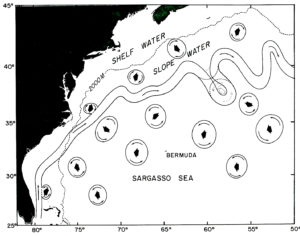Gulf Stream, Caribbean Current, North Brazil Current, ocean eddies
Studies of the northward flow of upper layer water that crosses the equator and the formation and movement of eddies in these currents.
Publications
Cherubin, L. M., and P. L. Richardson, 2007. Caribbean current variability and the influence of the Amazon and Orinoco freshwater plumes. Deep-Sea Research I, 54, 1451–1473.
Fratantoni, D. M., and P. L. Richardson, 2006. The evolution and demise of North Brazil Current Rings. Journal of Physical Oceanography, 36(7), 1241–1264.
Richardson, P. L., 2005. Caribbean Current and eddies as observed by surface drifters. Deep-Sea Research II, 52, 429–463.
Richardson, P. L., 2001. Florida Current, Gulf Stream and Labrador Current. In: Encyclopedia of Ocean Sciences, John H. Steele, Steve A. Thorpe, and Karl K. Turekian, Editors, Academic Press, San Diego; Vol. 2, pp. 1054–1064.
Muller-Karger, F., P. L. Richardson, and D. McGillicuddy, 1995. On the offshore dispersal of the Amazon's Plume in the North Atlantic. Deep-Sea Research, 42, 2127–2137.
Richardson, P. L., G. Hufford, R. Limeburner, and W. S. Brown, 1994. North Brazil current retroflection eddies. Journal of Geophysical Research, 99(C3), 5081–5093.
Richardson, Philip L., 1994. Giant eddies of South Atlantic water invade the north. Oceanus, 37(1), 19–21.
Richardson, P. L., 1993. Tracking ocean eddies. American Scientist, 81, 261–271.
Schmitz, William J., Jr., and Philip L. Richardson, 1991. On the sources of the Florida Current. Deep-Sea Research, 38, Suppl. 1, S379–S409.
Richardson, Philip L., 1991. SOFAR floats give a new view of ocean eddies. Oceanus, 34(1), 23–31.
Richardson, P. L., 1985. Average velocity and transport of the Gulf Stream near 55°W. Journal of Marine Research, 43(1), 83–111.
Richardson, Philip L., 1983. A vertical section of eddy kinetic energy through the Gulf Stream system. Journal of Geophysical Research, 88(C4), 2705–2709.
Richardson, Philip L., 1983. Eddy kinetic energy in the North Atlantic from surface drifters. Journal of Geophysical Research, 88(C7), 4355–4367.
Richardson, P. L., 1983. Gulf Stream rings. Chapter 2 in: Eddies in Marine Science, A. R. Robinson, editor, Springer-Verlag, Berlin, pp. 19–45.
Richardson, Philip L., 1980. Gulf Stream ring trajectories. Journal of Physical Oceanography, 10(1), 90–104.
Richardson, P. L., 1980. Progress on the Gulf Stream. The Geographical Magazine, London, LII(8), 575–581.
Richardson, P. L., R. E. Cheney, and L. V. Worthington, 1978. A census of Gulf Stream rings, spring 1975. Journal of Geophysical Research, 83(C12), 6136–6144.
Richardson, P. L., 1976. Gulf Stream rings. Oceanus, 19(3), 65–68.
Richardson, P. L., A. E. Strong, and J. A. Knauss, 1973. Gulf Stream eddies: recent observations in the western Sargasso Sea. Journal of Physical Oceanography, 3(3), 297–301.
Richardson, Philip L., and John A. Knauss, 1971. Gulf Stream and western boundary undercurrent observations at Cape Hatteras. Deep-Sea Research, 18, 1089–1109.
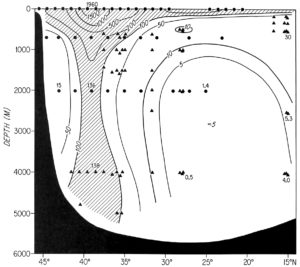
Schematic diagram of the number and distribution of Gulf Stream rings (upper figure, 1976) and vertical section across the Gulf Stream of the eddy kinetic energy from drifters, floats and current meters (lower figure, 1983).
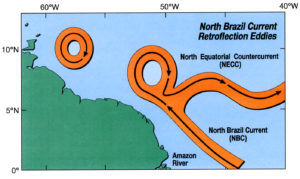
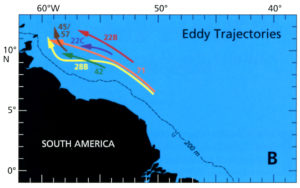
Schematic formation of a NBC Retroflection eddy (upper figure, 1994) and trajectories of several eddies tracked by floats and drifters (lower figure, 1994).
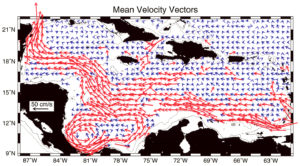
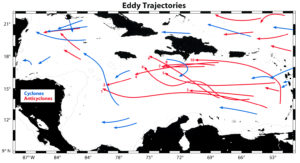
Average velocities in the Caribbean Current from surface drifters (upper figure, 2005). Trajectories of 19 cyclones (blue) and 19 anticyclones (red) inferred from looping drifter trajectories (lower figure, 2005).
